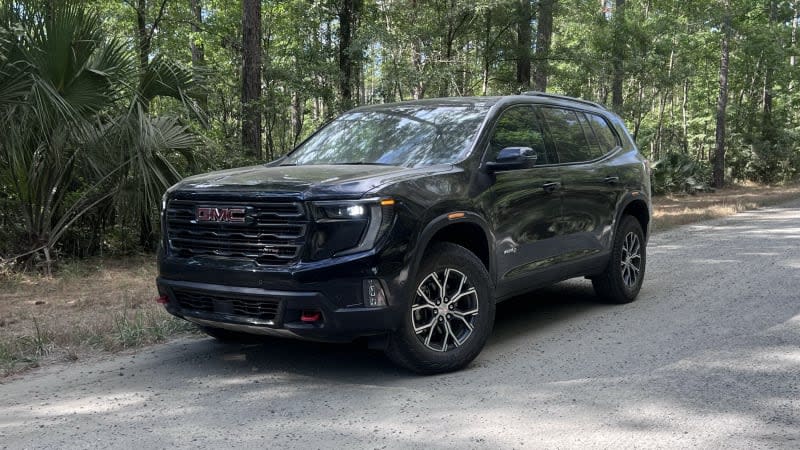2024 GMC Acadia First Drive Review: Big on character
BLUFFTON, S.C. — The 2024 GMC Acadia is a revamped take on the brand’s popular three-row SUV. It’s quite a bit bigger than the outgoing model, with 8.4 more inches of wheelbase and 10.6 extra inches of overall length. That’s a huge boon to cargo space (up 80%), while also adding 27% to second-row legroom. Its new looks align more closely now with the GMC Sierra pickup, granting it a brawnier personality.
While it’s in many ways quite similar to the updated 2024 Chevrolet Traverse, (including in size, now) GMC did an admirable amount of design work to differentiate the Acadia from its close relative. The tall, truck-like grille gives the Acadia more presence than before, and the C-shaped LED headlights add character. Along the side, the chunky C-pillar is hidden from sight, while the D-pillar is expanded. This provides a better view for third-row passengers, and has the added benefit of obscuring the cargo area from onlookers. Around back, we see more LED lighting, as well as quad exhaust tips GMC said were inspired by the C8 Chevy Corvette, complete with their squarish shape. The overall look is more truckish, but it still has a sporty slant.
Under the skin, much is shared with its Chevy platform-mate. It sports the same new 2.5-liter turbo four producing 328 horsepower and 326 pound-feet of torque and shifts via an eight-speed automatic transmission. The engine employs the same “ePhaser” to adjust the camshaft on the fly to advance and delay the spark according to power and efficiency needs. And just like the Traverse, the front-wheel-drive Acadia gets 20 miles per gallon city, 27 mpg highway and 23 mpg combined, or 19/24/21 mpg with all-wheel drive.
In addition to the base Elevation trim ($43,995 including destination, with AWD costing another $2,000), the Acadia boasts the more luxurious Denali trim ($55,695 for FWD and $57,695 for AWD), as well as the off-road-ready AT4 trim ($51,395 with AWD standard). We’ll have to wait to evaluate the feature content in the Elevation, but the Denali and AT4 were on hand for us to evaluate in South Carolina.



Our first stint in the Acadia was in the Denali. Getting inside, it’s immediately noticeable that the Acadia’s interior is a big step up over that of the Traverse. Up front, the centerpiece is the tech interface standard on all Acadia trims: a portrait-oriented 15-inch infotainment screen running Google Built-In, as well as an 11-inch driver display. The Denali also comes with a head-up display as standard. One feature that helped immensely (in both Acadias we drove) on unfamiliar roads was the ability to switch the instrument panel display to donate most of its real estate to mirror the Google Maps navigation, putting our directions directly in front of us while freeing up the infotainment screen for any other functions needed along the way. And, yes, this GM product still has Apple CarPlay and Android Auto.
The rest of the Denali’s interior design is inviting, with leather seats boasting truly attractive stitching. There are still some grainy, hard plastics to be found, but they don’t dominate the cabin. We really like the look of the open-pore ayous wood trim, complete with the Denali name etched at the far end of the dash. The fairing that covers the driver’s side of the dash is interestingly shaped, with good character for an element that would otherwise be easily overlooked both by designers and consumers. Its big center console is open underneath for convenient storage, thanks to GMC relocating the drive selector from the console to the steering column. We also appreciate the big, sturdy HVAC toggles integrated at the bottom of the infotainment screen.
Standard across the lineup is a seven-passenger layout with second-row captain’s chairs; there is no bench seat option. The second row is quite roomy, with seats that adjust backward and forward to offer more room or to punish whomever is sitting behind you. The third row is fairly large, though. With the driver’s seat in my ideal driver position and a comfortable second-row position behind that, I squeezed my 6-foot self into the third row and found my knees touching the seatback ahead of me. With a couple of minor adjustments from the forward seats — ones that wouldn’t be asking too much of the other occupants — I could fit in the third row fairly comfortably. A kid would be right at home for long trips. Adults would at least appreciate the decent headroom.


You could carry a good amount of luggage for all those passengers. Cargo volume behind the third row checks in at a segment-beating 23.0 cubic feet, with a large under-floor bin as a bonus. If it’s just a family of four taking the trip, flattening the third row opens that up to 57.3 cubic feet. Fold all the seats down for a maximum 97.5 cubes, and you’ve got a decent moving vehicle. There’s also 5,000 pounds worth of towing capacity if you somehow run out of space inside the Acadia.
Our particular Denali tester was equipped with the standard 20-inch wheels, not the optional 22-inchers and the “performance suspension” included in the Denali Reserve Package. That upgraded suspension uses passive, frequency-based dampers that behave differently according to input from the road. It’s probably more important to have when rolling on the bigger tires with their shorter sidewalls, but the 20-inchers with the standard suspension proved just fine for our drive. We didn’t encounter some of the tire-flattening, cratered pavement we see up in Michigan, but the imperfections we did encounter passed under tire without complaint.
GM’s Super Cruise hands-free driver assistance system is optional across the Acadia lineup, and our Denali had it. It’s still a great system, reducing fatigue and inspiring confidence in its abilities as it deftly moves along with traffic — or around it with automatic lane changes. As GM adds more mileage to its map of compatible roads (about 750,000 miles now!), we were sometimes surprised by some of the smaller highways it would work on. One such stretch of road had its share of intersections with stop lights. Ahead of some of these busier intersections, the Acadia would let us know to take over steering with a red light on the steering wheel, a message on the driver display and a vibration of the seat cushion (a great way to deliver an alert without freaking out any passengers on board). Super Cruise remains one of the more advanced driver assist systems that we actually enjoy using.
The 2.5-liter turbo engine felt like a good fit for the Acadia. While it may not seem as macho as a V6, it offered plenty of power to get and keep the Acadia moving. It doesn’t sound bad, either, and what you do hear isn’t very loud. Turbo lag is at a minimum, and there’s enough power on hand to get the front wheels to spin from a stop (which is accompanied by a suggestion on the driver display to switch to AWD mode). We’ll be interested to see if the engine still feels up to the task when loaded up with passengers and a trailer in tow, but nothing so far suggests it won’t.
The next morning, I got in the off-road-leaning Acadia AT4. That comes equipped with all-terrain tires mounted on 18-inch wheels. In all, the AT4 gains about 1.2 inches in ride height over the Elevation, about two-thirds of that coming from the suspension, while the tires account for the rest. The AT4 uses a version of the optional performance suspension from the Denali, though tuned for more rugged duty, and including the same hydraulic rebound stop found in the Chevy Traverse Z71. It also gets red tow hooks, underbody skid plates, a twin-clutch all-wheel drive system and Off-Road and Terrain drive modes. The exterior brightwork isn’t exactly bright, using tinted chrome that comes off as a broody, glossy graphite-ish color. We’d be remiss to ignore the AT4’s marker lights on its wheel arches — it’s a small detail, but a neat one, nonetheless.
Inside, the AT4 doesn’t automatically get the Denali’s standard features, like a head-up display, leather upholstery, ventilated front seats, heated second-row seats, one-touch-folding second-row and power-folding third-row seats, power steering column, memory settings and premium floor mats. Some of that is available, some not, but what you do get is still good and, we’d argue, suited to its purpose. The combination fabric and synthetic seats are comfortable and feel durable, and the rest of the interior design is still attractive, complete with wood trim. But despite fewer luxury trimmings, the AT4 feels even more special to drive.
The AT4 is particularly at home traversing down gravel roads at speeds that left huge plumes of dust behind us, the suspension doing an absolutely superb job of smoothing out the ruts and bumps. Once the gravel turned to fine, dry sand, the AT4 was a hoot. In Off-Road mode, it was perfectly happy to carry momentum and even accelerate fairly quickly through the loose medium. It felt a little playful, but not unruly as the front tires clawed through the sand, keeping the Acadia’s grille pointed where we wanted it. Just for fun, we switched the drive mode back to Normal mid-sand-rip, and the AT4 did indeed struggle to keep up momentum, slowing down significantly despite my inputs, as the traction control system fought against slippage. Popping it back into Off-Road mode via the (poorly placed) toggle to the left of the steering column, the Acadia was once again eager to charge forward as the AT4’s Active Torque Control AWD system allowed the wheels a little more freedom to spin.
GMC was kind enough to dig up one of the sandy roads on our drive route to let us get some wheels in the air. The AT4 was happy to creep through in Terrain mode without us having to fumble between the gas and brake pedals. Furthermore, every liftoff and touchdown of the wheels took place without drama — no noise, and managed with comfort (at least from the driver’s seat). We also turned on the vehicle’s exterior cameras, which would be useful if that portion of the trail had any turns.
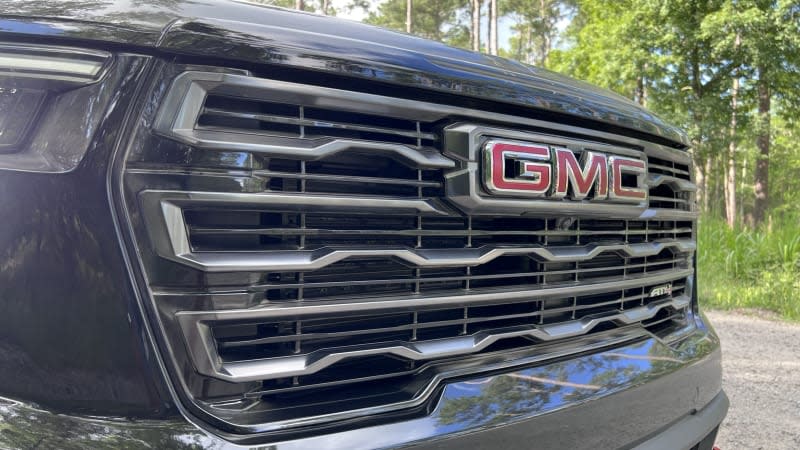
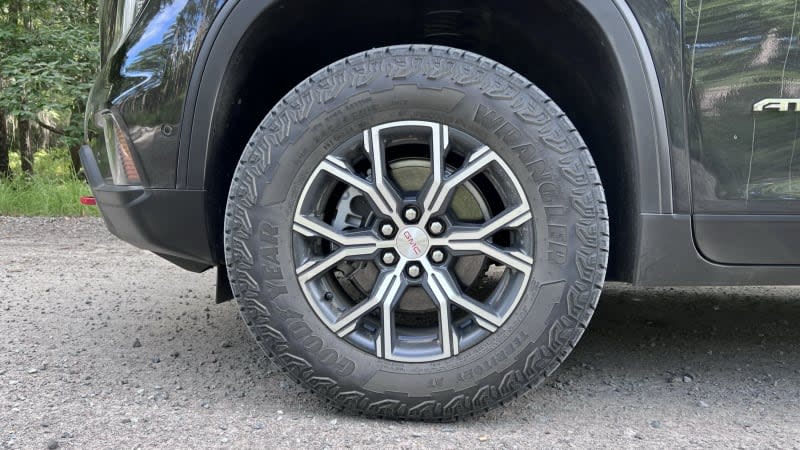
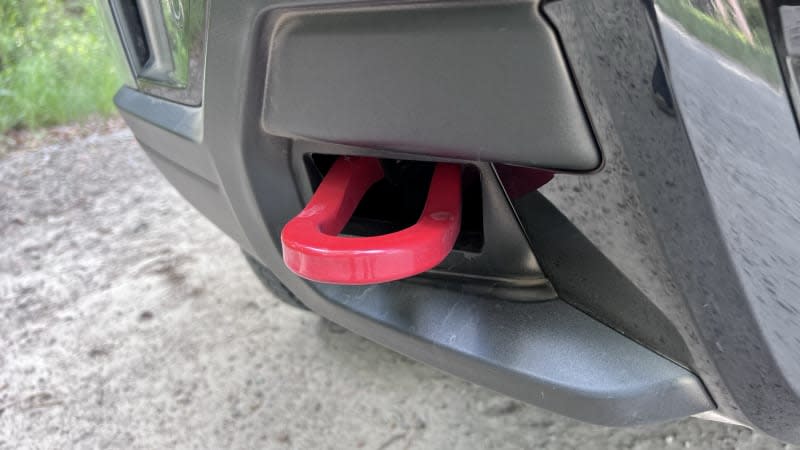
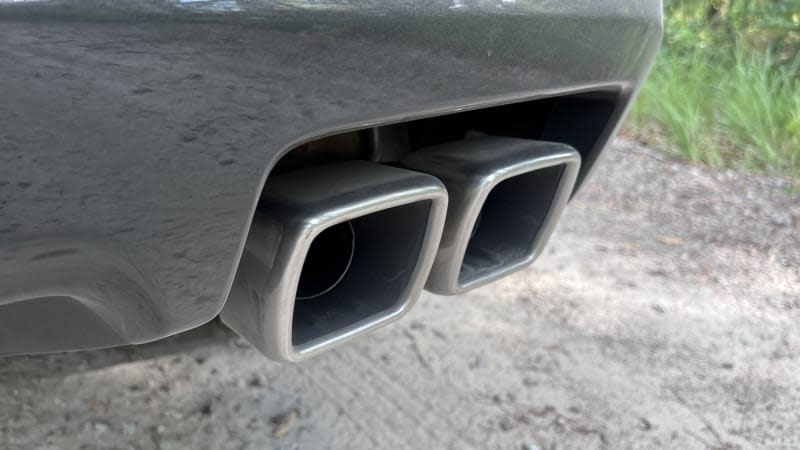
Later, when we’d come back to the same spot, newly refreshed by GMC’s on-hand earth-moving equipment, the sandy ruts were deep and loose enough to get the Acadia temporarily stuck, wheels spinning to no avail. There was no need to resort to the tow hooks, though, as backing up a couple of inches, then rolling the front wheel back onto the incline and keeping a steady foot on the accelerator was enough to allow the all-wheel-drive system to sort the torque enough to get us up and out of the pit and, eventually, back onto mostly level ground.
On the pavement, the AT4 proved just about as comfortable as the Denali we had driven the day before. We were able to elicit a bit more wheel spin from the all-terrain tires when gunning it from a stop, and they gave a little bit of a roar when we called upon its lateral grip reserves when pushing through a corner. Excess body roll didn’t pose a problem from the driver’s seat, and the sweet suspension continued to level out whatever came at it on the straight parts of the road, too.
Our AT4 was also equipped with Super Cruise, which worked just as well as it did in the Denali. The only difference was that we noticed a bit more correction from the steering system, with just a slight wobble of the steering wheel on center as it cruised down the highway. That did not translate into any extra motion in the cabin, however, as everything felt calm and stable as we chugged straight ahead with our hands in our lap.
The 2024 Acadia is an attractive three-row SUV, perhaps more so than the slightly more affordable Chevy Traverse — even more affordable than that if you walk further down the Chevy’s deeper trim lineup. The Acadia’s exterior design is unique, and its interior design is a big draw over its cousin when comparing these comparable trims. Is that worth an extra few grand to you? Because beyond that, there’s not a lot, especially in terms of driving, that sets it apart from the Traverse. With that in mind, it’s simple enough to go test them back to back; they’re both in dealerships now, and they represent big upgrades over their outgoing versions.
Related video:
You Might Also Like


